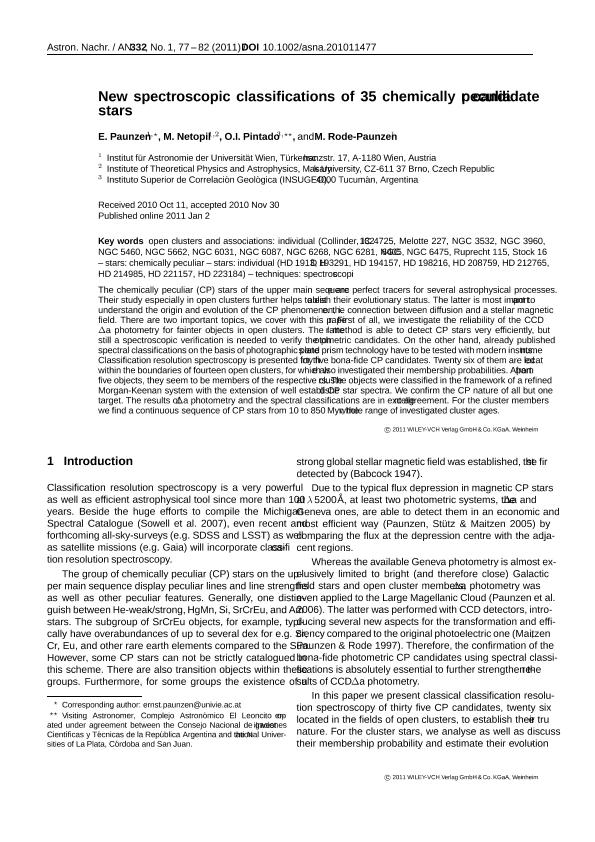Mostrar el registro sencillo del ítem
dc.contributor.author
Paunzen, E.
dc.contributor.author
Netopil, M.
dc.contributor.author
Pintado, Olga Ines

dc.contributor.author
Rode Paunzen, M.
dc.date.available
2019-11-26T17:19:25Z
dc.date.issued
2011-01
dc.identifier.citation
Paunzen, E.; Netopil, M.; Pintado, Olga Ines; Rode Paunzen, M.; New spectroscopic classifications of 35 chemically peculiar candidate stars; Wiley VCH Verlag; Astronomische Nachrichten; 32; 1; 1-2011; 77-82
dc.identifier.issn
0004-6337
dc.identifier.uri
http://hdl.handle.net/11336/90511
dc.description.abstract
The chemically peculiar (CP) stars of the upper main sequence are perfect tracers for several astrophysical processes.<br />Their study especially in open clusters further helps to establish their evolutionary status. The latter is most important to<br />understand the origin and evolution of the CP phenomenon, i.e. the connection between diffusion and a stellar magnetic<br />field. There are two important topics, we cover with this paper. First of all, we investigate the reliability of the CCD<br />a photometry for fainter objects in open clusters. The latter method is able to detect CP stars very efficiently, but<br />still a spectroscopic verification is needed to verify the photometric candidates. On the other hand, already published<br />spectral classifications on the basis of photographic plates and prismtechnology have to be tested withmodern instruments.<br />Classification resolution spectroscopy is presented for thirty five bona-fide CP candidates. Twenty six of them are located<br />within the boundaries of fourteen open clusters, for which we also investigated their membership probabilities. Apart from<br />five objects, they seem to be members of the respective clusters. The objects were classified in the framework of a refined<br />Morgan-Keenan system with the extension of well established CP star spectra. We confirm the CP nature of all but one<br />target. The results of a photometry and the spectral classifications are in excellent agreement. For the cluster members<br />we find a continuous sequence of CP stars from 10 to 850Myr, the whole range of investigated cluster ages.<br /><br />
dc.format
application/pdf
dc.language.iso
eng
dc.publisher
Wiley VCH Verlag

dc.rights
info:eu-repo/semantics/openAccess
dc.rights.uri
https://creativecommons.org/licenses/by-nc-sa/2.5/ar/
dc.subject
Open Clusters And Associations
dc.subject
Star:Chemically Peculiar
dc.subject
Spectroscopic
dc.subject.classification
Astronomía

dc.subject.classification
Ciencias Físicas

dc.subject.classification
CIENCIAS NATURALES Y EXACTAS

dc.title
New spectroscopic classifications of 35 chemically peculiar candidate stars
dc.type
info:eu-repo/semantics/article
dc.type
info:ar-repo/semantics/artículo
dc.type
info:eu-repo/semantics/publishedVersion
dc.date.updated
2019-06-04T15:59:40Z
dc.journal.volume
32
dc.journal.number
1
dc.journal.pagination
77-82
dc.journal.pais
Alemania

dc.journal.ciudad
Heidelberg
dc.description.fil
Fil: Paunzen, E.. Institut für Astronomie der Universität Wien; Austria
dc.description.fil
Fil: Netopil, M.. Institut für Astronomie der Universität Wien; Austria. Masaryk University; República Checa
dc.description.fil
Fil: Pintado, Olga Ines. Consejo Nacional de Investigaciones Científicas y Técnicas. Centro Científico Tecnológico Conicet - Tucumán. Instituto Superior de Correlación Geológica. Universidad Nacional de Tucumán. Facultad de Ciencias Naturales e Instituto Miguel Lillo. Departamento de Geología. Cátedra Geología Estructural. Instituto Superior de Correlación Geológica; Argentina
dc.description.fil
Fil: Rode Paunzen, M.. Institut für Astronomie der Universität Wien; Austria
dc.journal.title
Astronomische Nachrichten

dc.relation.alternativeid
info:eu-repo/semantics/altIdentifier/doi/https://dx.doi.org/10.1002/asna.201011477
dc.relation.alternativeid
info:eu-repo/semantics/altIdentifier/url/https://onlinelibrary.wiley.com/doi/abs/10.1002/asna.201011477
Archivos asociados
